Sweet chestnuts are one of the secrets behind Josh Hill’s homegrown cured-meats business, Poaka
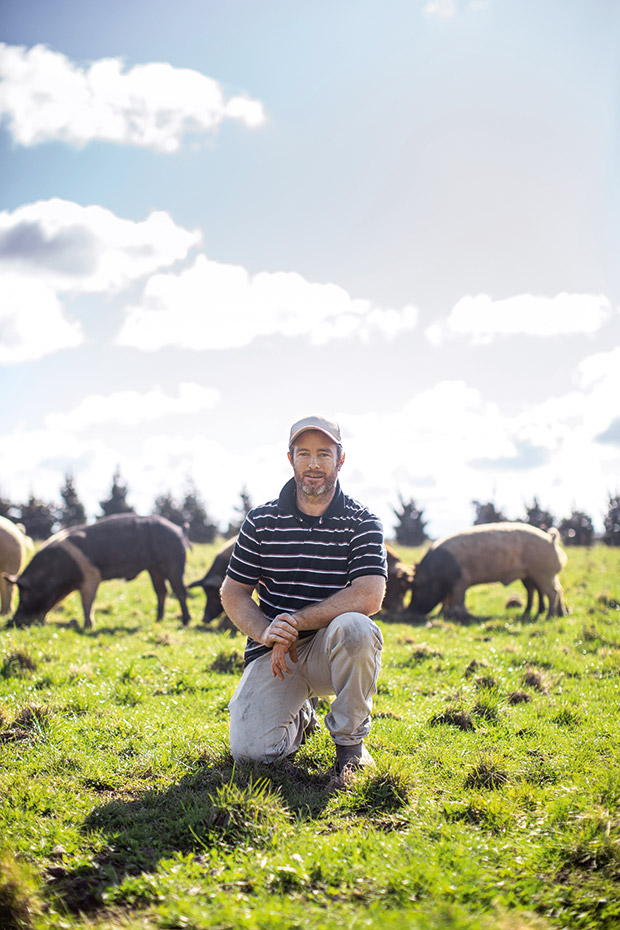
It’s no wonder Josh Hill’s pigs produce melt-in-the-mouth cured meats, feasting as they do on a diet of Canterbury sunshine and homegrown chestnuts.
Words: Nicole Barratt Photos: Kirsty Middleton
Josh Hill’s parents weren’t sure what to say when their son arrived home from a trip to Gore with an out-of-the-blue plan to raise pigs. Josh explained that he wanted them to be free to wander the family farm, free to munch on hectares of sweet chestnut trees. Although not quite as enamoured at the idea of 100-kilogramme heritage porkers roaming the property, Mum and Dad gave Josh the go-ahead to start his European-style cured meats business, Poaka.
“I had the idea in 2016 while I was on a mate’s farm in Gore — he’d snapped his Achilles tendon playing rugby, so I was helping him out. I realized I love working with animals and the rural sector, and I wanted to be involved,” Josh says. Other than 10 hectares of chestnut trees planted by his father 30 years ago, the 40-hectare farm Josh had grown up on in Aylesbury had mainly been leased out to other farmers for grazing.
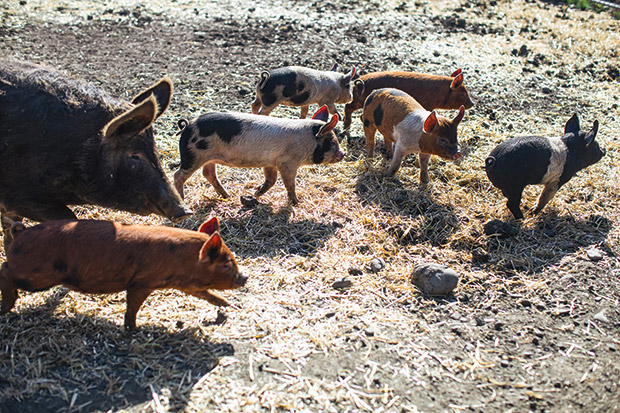
“In the 1990s, nuts were thought to be the next big thing, so dad planted the trees. They never really made any money off them, so that got me thinking about how we could utilize the chestnuts.”
Josh knew that the finest cold-cut pork products in Europe came from pigs who grazed, in autumn, under trees for chestnuts. He recognized a gap in the local market for high-end pork and charcuterie products.
And he knew what he was aiming for: quality charcuterie produced as ethically and sustainably as possible. He landed on purchasing three heritage English breeds of pigs renowned for their flavour: wessex saddleback, tamworth and berkshire (heritage breeds grow more slowly, forage well and develop a succulent fat layer). “It was a simple dream. I wanted to make the best salami from the happiest heritage pigs and feed them chestnuts.”
Tracking down his pigs wasn’t easy. Heritage breed pigs aren’t farmed in significant numbers in New Zealand, so the process involved much trawling of Trade Me and trips to Havelock and Gore to pick them up. “My very first pig was Brown Girl; she’s had lots of piglets now. Although I try not to get too attached to any of the pigs, I certainly couldn’t turn her into salami.”
Josh’s learning curve for dealing with pigs was steep. He’d had experience with sheep and cows growing up. He was also a jack-of-all-trades (having worked stints as a helicopter pilot, carpenter and general engineer). “But pigs aren’t sheep or cattle; you can’t herd them — thankfully, they’re extremely food-motivated. You must be quiet and gentle because they’re unbelievably strong, like big meat torpedoes.” He also learnt pigs churned through an astonishing amount of grass.
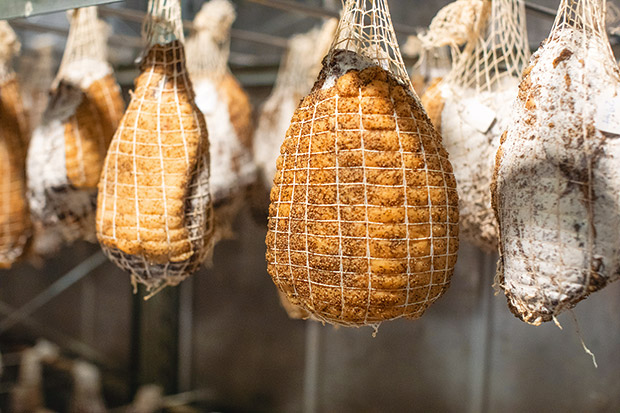
He sought advice on charcuterie from local butchers while visiting family in France near the Spanish border (an area renowned for its mouth-watering nut-finished charcuterie). The chefs showed him its fundamentals; then, it was back to Christchurch for trial batches.
Josh suffered a few failures early on, and the work was time-consuming — salamis are fermented and then matured for up to four months. “It’s not rocket science; people have been preparing meat this way for centuries. But there are subtleties and plenty of things I had to learn.”
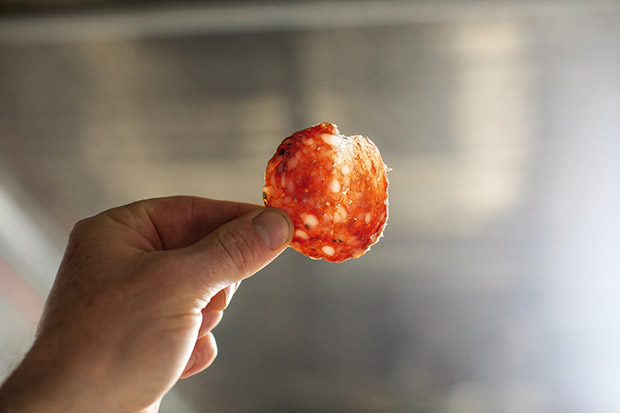
The depth of flavour comes from the pigs’ happy lifestyles. His pigs take about 16 months to reach maturity, fed on pasture grasses and barley from a neighbouring farmer, then finished on the chestnuts. The variation in diet and exercise in the paddocks produces the flavour. Their layer of back fat is twice as thick and much softer than standard farmed pigs. “Good things take time, though; that was another learning curve,” says Josh.
Most pigs in New Zealand are killed at six months old and at about 60 kilogrammes; Josh’s heritage breeds grow to about 100 to 120 kilogrammes. It’s bitter-sweet taking the pigs on a final field trip to the abattoir. “They’ve had a fantastic life, and the best thing I can do to honour them is turn them into the best charcuterie I can turn my hand at.” Maturing meat cuts takes plenty of patience — dry cured coppa (marbled meat with a peppery crust) takes a minimum of four months to reach its best eating point. Salamis hang for a further six to 10 weeks.
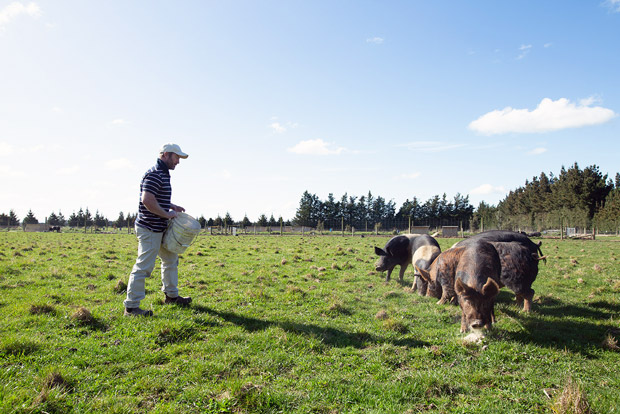
Poaka launched at the Christchurch Farmers’ Market to an enthusiastic audience of tasters who devoured slices of finocchiona (fennel seed) salami and coppa. But the pandemic gave the business a battering it only just prevailed. “It was a scramble for survival; our main channels were direct to customers, the market and the hospitality industry, and that all dried up overnight. Thankfully, we’d just got in with Foodstuffs in the South Island, so we could keep going with bacon and sausages.”
Initially, Poaka outsourced its processing, but it’s now done on-site at a purpose-built butchery and drying area in shipping containers. “There have certainly been a few hard yakka years, but we’re passionate about our pigs and where we’re headed.” Josh’s homegrown charcuterie lines shelves in Farro Fresh in the North Island and Foodstuffs stores in the South and is popular with plenty of chefs and home cooks who buy it online.
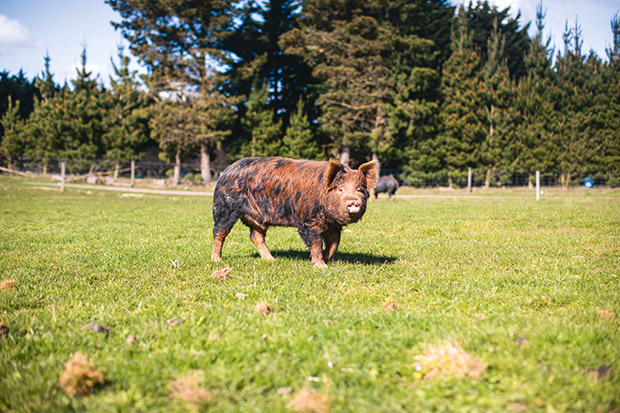
He’s passionate about sustainability. “Virtually all our packaging is cardboard; we use a natural casing and all-natural ingredients. We aim to have completely compostable packaging with no plastic, though tracking down a supplier has been trickier than I thought.” He’s also passionate about transparency and fairness in the pork industry — more than 60 per cent of the pork eaten in New Zealand comes from overseas, and there’s no standard farms must meet for it to be imported. “That’s the scary thing about the pork industry; people have no idea where it comes from and how it was farmed. I’m all about connecting people to where their food is coming from.”
Though Josh has donned many hats in his life, he feels he’s found his calling. “I’ve found my foothold and what I want to do for as long as I can.” His pigs, baking in the sun with bellies full of chestnuts, certainly hope he does. poaka.co.nz
THE ART OF PRESERVING MEATS
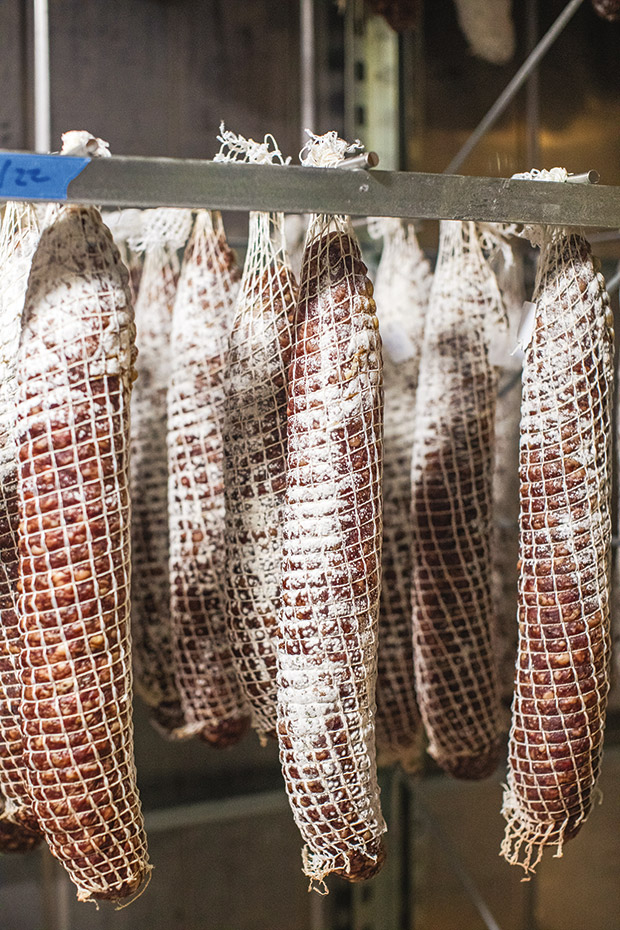
Cured and preserved meats date back to 3000BC when preservatives and refrigeration didn’t exist. In Mesopotamia, meat and fish were preserved in sesame oil and dried and salted when food was scarce. Salt curing was common by 200BC in Greece and popular in the Roman Empire. “It’s an art form, with people well before my time doing this,” Josh says. “I learned a lot from scratch, getting pointers from the guys over in France and Spain. I went to some obscure places where I saw hams that had been hanging for two or three years, uncooked and with no preservatives, just salt and time.” Josh is passionate about preserving and continuing this knowledge.
“Preserved meats are in an absolute league of their own in Europe — we have supermarket aisles here dedicated to chips; they have aisles dedicated to cured meats and sun-dried tomatoes. There’s a real emphasis on quality, fresh foods.” Poaka’s current youngest taste-tester and helper is Josh’s two-year-old son, Luke. “He’s a great pig feeder and loves to ride shotgun on the tractor; it gives mum [Paula] a good break.” poaka.co.nz
Love this story? Subscribe now!
 This article first appeared in NZ Life & Leisure Magazine.
This article first appeared in NZ Life & Leisure Magazine.
